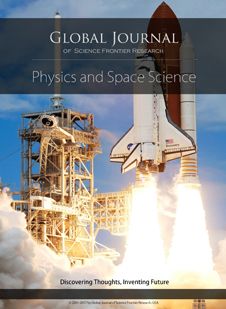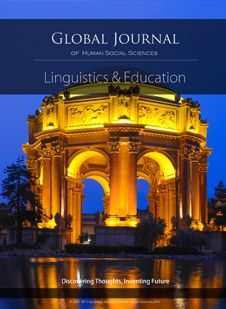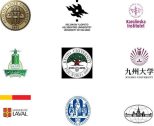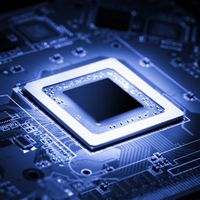The GJCST Computing Classification System

Please note that your paper should be classified as of our following classification scheme. GJCST Classification should be filled in "Submit Manuscript" form.
This helps in:
1. Proper Indexing and Citation of your paper/article.
2. Perfect categorization facilitates reader a quick reference and related papers.
3. Update your research advances worldwide.
4. Helps us in fast peer reviewing process.
5. Correct placements in review papers.
if you have any problems, feel free to contact us.
To Navigate, Click on your research stream Segment (To come back here, simply click on 'Back to Top' there)
Segments
Segment A. General Literature
Segment B. Hardware
Segment C. Computer Systems Organization
Segment D. Software
Segment E. Data
Segment F. Theory of Computation
Segment G. Mathematics of Computing
Segment H. Information Systems
Segment I. Computing Methodologies
Segment J. Computer Applications
Segment K. Computing Milieux
Sub-Segments
- B.0 GENERAL
- B.1 CONTROL STRUCTURES AND MICROPROGRAMMING
- B.2 ARITHMETIC AND LOGIC STRUCTURES
- B.3 MEMORY STRUCTURES
- B.4 INPUT/OUTPUT AND DATA COMMUNICATIONS
- B.5 REGISTER-TRANSFER-LEVEL IMPLEMENTATION
- B.6 LOGIC DESIGN
- B.7 INTEGRATED CIRCUITS
- B.8 PERFORMANCE AND RELIABLITY
- B.m MISCELLANEOUS
C. Computer Systems Organization
- C.0 GENERAL
- C.1 PROCESSOR ARCHITECTURES
- C.2 COMPUTER-COMMUNICATION NETWORKS
- C.3 SPECIAL-PURPOSE AND APPLICATION-BASED SYSTEMS
- C.4 PERFORMANCE OF SYSTEMS
- C.5 COMPUTER SYSTEM IMPLEMENTATION
- C.m MISCELLANEOUS
- D.0 GENERAL
- D.1 PROGRAMMING TECHNIQUES
- D.2 SOFTWARE ENGINEERING
- D.3 PROGRAMMING LANGUAGES
- D.4 OPERATING SYSTEMS
- D.m MISCELLANEOUS
- E.0 GENERAL
- E.1 DATA STRUCTURES
- E.2 DATA STORAGE REPRESENTATIONS
- E.3 DATA ENCRYPTION
- E.4 CODING AND INFORMATION THEORY
- E.5 FILES
- E.m MISCELLANEOUS
- F.0 GENERAL
- F.1 COMPUTATION BY ABSTRACT DEVICES
- F.2 ANALYSIS OF ALGORITHMS AND PROBLEM COMPLEXITY
- F.3 LOGICS AND MEANINGS OF PROGRAMS
- F.4 MATHEMATICAL LOGIC AND FORMAL LANGUAGES
- F.m MISCELLANEOUS
- G.0 GENERAL
- G.1 NUMERICAL ANALYSIS
- G.2 DISCRETE MATHEMATICS
- G.3 PROBABILITY AND STATISTICS
- G.4 MATHEMATICAL SOFTWARE
- G.m MISCELLANEOUS
- H.0 GENERAL
- H.1 MODELS AND PRINCIPLES
- H.2 DATABASE MANAGEMENT
- H.3 INFORMATION STORAGE AND RETRIEVAL
- H.4 INFORMATION SYSTEMS APPLICATIONS
- H.5 INFORMATION INTERFACES AND PRESENTATION (I.7)
- H.m MISCELLANEOUS
- I.0 GENERAL
- I.1 SYMBOLIC AND ALGEBRAIC MANIPULATION
- I.2 ARTIFICIAL INTELLIGENCE
- I.3 COMPUTER GRAPHICS
- I.4 IMAGE PROCESSING AND COMPUTER VISION
- I.5 PATTERN RECOGNITION
- I.6 SIMULATION AND MODELING
- I.7 DOCUMENT AND TEXT PROCESSING
- I.m MISCELLANEOUS
- J.0 GENERAL
- J.1 ADMINISTRATIVE DATA PROCESSING
- J.2 PHYSICAL SCIENCES AND ENGINEERING
- J.3 LIFE AND MEDICAL SCIENCES
- J.4 SOCIAL AND BEHAVIORAL SCIENCES
- J.5 ARTS AND HUMANITIES
- J.6 COMPUTER-AIDED ENGINEERING
- J.7 COMPUTERS IN OTHER SYSTEMS
- J.m MISCELLANEOUS
- K.0 GENERAL
- K.1 THE COMPUTER INDUSTRY
- K.2 HISTORY OF COMPUTING
- K.3 COMPUTERS AND EDUCATION
- K.4 COMPUTERS AND SOCIETY
- K.5 LEGAL ASPECTS OF COMPUTING
- K.6 MANAGEMENT OF COMPUTING AND INFORMATION SYSTEMS
- K.7 THE COMPUTING PROFESSION
- K.8 PERSONAL COMPUTING
- K.m MISCELLANEOUS
Detailed Categories
- A. General Literature
-
B. Hardware
- B.0 GENERAL
- B.1 CONTROL STRUCTURES AND MICROPROGRAMMING (D.3.2)
- B.2ARITHMETIC AND LOGIC STRUCTURES
- B.3MEMORY STRUCTURES
-
B.4INPUT/OUTPUT AND DATA COMMUNICATIONS
- B.4.0 General
- B.4.1 Data Communications Devices
-
B.4.2Input/Output Devices
- Channels and controllers
- Data terminals and printers
- Image display
- Voice
-
B.4.3Interconnections (Subsystems)
- Asynchronous/synchronous operation
- Fiber optics
- Interfaces
- Parallel I/O
- Topology (e.g., bus, point-to-point)
- B.4.m Miscellaneous
- B.5REGISTER-TRANSFER-LEVEL IMPLEMENTATION
- B.6LOGIC DESIGN
-
B.7INTEGRATED CIRCUITS
- B.7.0 General
-
B.7.1Types and Design Styles
- Advanced technologies
- Algorithms implemented in hardware
- Gate arrays
- Input/output circuits
- Memory technologies
- Microprocessors and microcomputers
- VLSI (very large scale integration)
-
B.7.2Design Aids
- Graphics
- Layout
- Placement and routing
- Simulation
- Verification
- B.7.m Miscellaneous
- B.8 PERFORMANCE AND RELIABILITY (C.4)
-
B.mMISCELLANEOUS
- Design management
-
C. Computer Systems Organization
-
C.0GENERAL
- Hardware/software interfaces
- Instruction set design (e.g., RISC, CISC, VLIW)

- Modeling of computer architecture
- System architectures
- Systems specification methodology
-
C.1PROCESSOR ARCHITECTURES
- C.1.0 General
-
C.1.1Single Data Stream Architectures
- RISC/CISC, VLIW architectures
-
C.1.2Multiple Data Stream Architectures (Multiprocessors)
- Array and vector processors
- Associative processors
- Connection machines
- Interconnection architectures (e.g., common bus, multiport memory, crossbar switch)
- Multiple-instruction-stream, multiple-data-stream processors (MIMD)
- Single-instruction-stream, multiple-data-stream processors (SIMD)
-
C.1.3Other Architecture Styles
- Adaptable architectures
- Analog computers
- Cellular architecture (e.g., mobile)

- Data-flow architectures
- Heterogeneous (hybrid) systems
- Neural nets
- Pipeline processors
-
C.1.4Parallel Architectures
- Distributed architectures
- Mobile processors
- C.1.m Miscellaneous
-
C.2COMPUTER-COMMUNICATION NETWORKS
-
C.2.0General
- Data communications
- Open Systems Interconnection reference model (OSI)
- Security and protection (e.g., firewalls)

-
C.2.1Network Architecture and Design
- Asynchronous Transfer Mode (ATM)
- Circuit-switching networks
- Distributed networks
- Frame relay networks
- ISDN (Integrated Services Digital Network)
- Network communications
- Network topology
- Packet-switching networks

- Store and forward networks
- Wireless communication
-
C.2.2Network Protocols
- Applications (SMTP, FTP, etc.)
- Protocol architecture (OSI model)

- Protocol verification
- Routing protocols
-
C.2.3Network Operations
- Network management
- Network monitoring
- Public networks
-
C.2.4Distributed Systems
- Client/server
- Distributed applications
- Distributed databases
- Network operating systems
-
C.2.5 Local and Wide-Area Networks

- Access schemes
- Buses
- Ethernet (e.g., CSMA/CD)
- High-speed (e.g., FDDI, fiber channel, ATM)
- Internet (e.g., TCP/IP)
- Token rings

-
C.2.6 Internetworking (C.2.2)
- Routers
- Standards (e.g., TCP/IP)
- C.2.m Miscellaneous
-
C.2.0General
-
C.3 SPECIAL-PURPOSE AND APPLICATION-BASED SYSTEMS (J.7)
- Microprocessor/microcomputer applications
- Process control systems
- Real-time and embedded systems

- Signal processing systems
- Smartcards
-
C.4PERFORMANCE OF SYSTEMS
- Design studies
- Fault tolerance
- Measurement techniques
- Modeling techniques
- Performance attributes
- Reliability, availability, and serviceability
- C.5COMPUTER SYSTEM IMPLEMENTATION
- C.m MISCELLANEOUS
-
C.0GENERAL
-
D.Software
- D.0 GENERAL
-
D.1 PROGRAMMING TECHNIQUES (E)
- D.1.0 General
- D.1.1 Applicative (Functional) Programming
- D.1.2 Automatic Programming (I.2.2)
-
D.1.3Concurrent Programming
- Distributed programming
- Parallel programming
- D.1.4 Sequential Programming
- D.1.5 Object-oriented Programming
- D.1.6 Logic Programming
- D.1.7 Visual Programming
- D.1.m Miscellaneous
-
D.2 SOFTWARE ENGINEERING (K.6.3)
-
D.2.0 General (K.5.1)
- Protection mechanisms
- Standards
-
D.2.1 Requirements/Specifications (D.3.1)
- Elicitation methods (e.g., rapid prototyping, interviews, JAD)
- Languages
- Methodologies (e.g., object-oriented, structured)

- Tools
-
D.2.2 Design Tools and Techniques

- Computer-aided software engineering (CASE)
- Decision tables
- Evolutionary prototyping
- Flow charts
- Modules and interfaces
- Object-oriented design methods
- Petri nets
- Software libraries
- State diagrams
- User interfaces
-
D.2.3 Coding Tools and Techniques

- Object-oriented programming
- Pretty printers
- Program editors
- Standards
- Structured programming
- Top-down programming
-
D.2.4 Software/Program Verification
 (F.3.1)
(F.3.1)
- Assertion checkers
- Class invariants
- Correctness proofs
- Formal methods
- Model checking
- Programming by contract
- Reliability
- Statistical methods
- Validation
-
D.2.5Testing and Debugging
- Code inspections and walk-throughs
- Debugging aids
- Diagnostics
- Distributed debugging
- Error handling and recovery
- Monitors
- Symbolic execution
- Testing tools (e.g., data generators, coverage testing)

- Tracing
-
D.2.6Programming Environments
- Graphical environments
- Integrated environments
- Interactive environments

- Programmer workbench
-
D.2.7 Distribution, Maintenance, and Enhancement

- Documentation
- Portability
- Restructuring, reverse engineering, and reengineering

- Version control
-
D.2.8 Metrics (D.4.8)
- Complexity measures
- Performance measures
- Process metrics
- Product metrics
-
D.2.9 Management (K.6.3, K.6.4)
- Cost estimation
- Life cycle
- Productivity
- Programming teams
- Software configuration management
- Software process models (e.g., CMM, ISO, PSP)
- Software quality assurance (SQA)
- Time estimation
-
D.2.11Software Architectures
- Data abstraction
- Domain-specific architectures
- Information hiding
- Languages (e.g., description, interconnection, definition)
- Patterns (e.g., client/server, pipeline, blackboard)
-
D.2.12Interoperability
- Data mapping
- Distributed objects
- Interface definition languages
-
D.2.13Reusable Software
- Domain engineering
- Reusable libraries
- Reuse models
- D.2.m Miscellaneous
-
D.2.0 General (K.5.1)
-
D.3PROGRAMMING LANGUAGES
-
D.3.0General
- Standards
-
D.3.1 Formal Definitions and Theory (D.2.1, F.3.1, F.3.2, F.4.2, F.4.3)
- Semantics
- Syntax
-
D.3.2Language Classifications
- Applicative (functional) languages

- Concurrent, distributed, and parallel languages
- Constraint and logic languages
- Data-flow languages
- Design languages
- Extensible languages
- Macro and assembly languages
- Multiparadigm languages
- Object-oriented languages
- Specialized application languages
- Very high-level languages
- Applicative (functional) languages
-
D.3.3 Language Constructs and Features (E.2)
- Abstract data types
- Classes and objects
- Concurrent programming structures
- Constraints
- Control structures
- Coroutines
- Data types and structures
- Dynamic storage management
- Frameworks
- Inheritance
- Input/output
- Modules, packages
- Patterns
- Polymorphism
- Procedures, functions, and subroutines
- Recursion
-
D.3.4Processors
- Code generation
- Compilers
- Debuggers
- Incremental compilers
- Interpreters
- Memory management (garbage collection)
- Optimization
- Parsing
- Preprocessors
- Retargetable compilers
- Run-time environments
- Translator writing systems and compiler generators
- D.3.m Miscellaneous
-
D.3.0General
-
D.4 OPERATING SYSTEMS (C)
- D.4.0 General
-
D.4.1Process Management
- Concurrency
- Deadlocks
- Multiprocessing/multiprogramming/multitasking

- Mutual exclusion
- Scheduling
- Synchronization
- Threads
-
D.4.2Storage Management
- Allocation/deallocation strategies
- Distributed memories
- Garbage collection
- Main memory
- Secondary storage
- Storage hierarchies
- Virtual memory
-
D.4.3 File Systems Management (E.5)
- Access methods
- Directory structures
- Distributed file systems
- File organization
-
D.4.4 Communications Management (C.2)
- Buffering
- Input/output
- Message sending
- Network communication
-
D.4.5Reliability
- Backup procedures
- Checkpoint/restart
- Fault-tolerance
- Verification
-
D.4.6 Security and Protection (K.6.5)
- Access controls
- Authentication
- Cryptographic controls
- Information flow controls
- Invasive software (e.g., viruses, worms, Trojan horses)
-
D.4.7 Organization and Design
- Distributed systems
- Interactive systems
- Real-time systems and embedded systems
-
D.4.8 Performance (C.4, D.2.8, I.6)
- Measurements
- Modeling and prediction
- Monitors
- Operational analysis
- Queueing theory
- Simulation
- Stochastic analysis
-
D.4.9Systems Programs and Utilities
- Command and control languages
- Window managers
- D.4.m Miscellaneous
- D.m MISCELLANEOUS
-
E. Data
- E.0 GENERAL
-
E.1DATA STRUCTURES
- Arrays
- Distributed data structures
- Graphs and networks

- Lists, stacks, and queues

- Records
- Trees
-
E.2DATA STORAGE REPRESENTATIONS
- Hash-table representations
- Linked representations
- Object representation
-
E.3DATA ENCRYPTION
- Code breaking
- Public key cryptosystems
- Standards (e.g., DES, PGP, RSA)
-
E.4 CODING AND INFORMATION THEORY (H.1.1)
- Data compaction and compression
- Error control codes
- Formal models of communication
-
E.5 FILES (D.4.3, F.2.2, H.2)
- Backup/recovery
- Organization/structure
- Sorting/searching
- E.m MISCELLANEOUS
-
F. Theory of Computation
- F.0 GENERAL
-
F.1COMPUTATION BY ABSTRACT DEVICES
- F.1.0 General
-
F.1.1 Models of Computation (F.4.1)
- Automata (e.g., finite, push-down, resource-bounded)
- Bounded-action devices (e.g., Turing machines, random access machines)
- Computability theory
- Relations between models
- Self-modifying machines (e.g., neural networks)
- Unbounded-action devices (e.g., cellular automata, circuits, networks of machines)
-
F.1.2Modes of Computation
- Alternation and nondeterminism
- Interactive and reactive computation

- Online computation
- Parallelism and concurrency
- Probabilistic computation
- Relativized computation
-
F.1.3 Complexity Measures and Classes
 (F.2)
(F.2)
- Complexity hierarchies
- Reducibility and completeness
- Relations among complexity classes
- Relations among complexity measures
- F.1.m Miscellaneous
-
F.2 ANALYSIS OF ALGORITHMS AND PROBLEM COMPLEXITY (B.6, B.7, F.1.3)
- F.2.0 General
-
F.2.1 Numerical Algorithms and Problems (G.1, G.4, I.1)
- Computation of transforms (e.g., fast Fourier transform)
- Computations in finite fields
- Computations on matrices
- Computations on polynomials
- Number-theoretic computations (e.g., factoring, primality testing)
-
F.2.2 Nonnumerical Algorithms and Problems (E.2, E.3, E.4, E.5, G.2, H.2, H.3)
- Complexity of proof procedures
- Computations on discrete structures
- Geometrical problems and computations
- Pattern matching
- Routing and layout
- Sequencing and scheduling
- Sorting and searching
- F.2.3 Tradeoffs between Complexity Measures (F.1.3)
- F.2.m Miscellaneous
-
F.3LOGICS AND MEANINGS OF PROGRAMS
- F.3.0 General
-
F.3.1 Specifying and Verifying and Reasoning about Programs (D.2.1, D.2.4, D.3.1, E.1)
- Assertions
- Invariants
- Logics of programs
- Mechanical verification
- Pre- and post-conditions
- Specification techniques
-
F.3.2 Semantics of Programming Languages (D.3.1)
- Algebraic approaches to semantics
- Denotational semantics
- Operational semantics
- Partial evaluation
- Process models
- Program analysis
-
F.3.3 Studies of Program Constructs (D.3.2, D.3.3)
- Control primitives
- Functional constructs
- Object-oriented constructs
- Program and recursion schemes
- Type structure
- F.3.m Miscellaneous
-
F.4MATHEMATICAL LOGIC AND FORMAL LANGUAGES
- F.4.0 General
-
F.4.1 Mathematical Logic (F.1.1, I.2.2, I.2.3, I.2.4)
- Computability theory
- Computational logic
- Lambda calculus and related systems
- Logic and constraint programming

- Mechanical theorem proving
- Modal logic
- Model theory
- Proof theory
- Recursive function theory
- Set theory
- Temporal logic
-
F.4.2 Grammars and Other Rewriting Systems (D.3.1)
- Decision problems
- Grammar types (e.g., context-free, context-sensitive)
- Parallel rewriting systems (e.g., developmental systems, L-systems)
- Parsing
- Thue systems
-
F.4.3 Formal Languages (D.3.1)
- Algebraic language theory
- Classes defined by grammars or automata (e.g., context-free languages, regular sets, recursive sets)
- Decision problems
- Operations on languages
- F.4.m Miscellaneous
- F.m MISCELLANEOUS
-
G. Mathematics of Computing
- G.0 GENERAL
-
G.1NUMERICAL ANALYSIS
-
G.1.0General
- Computer arithmetic
- Conditioning (and ill-conditioning)

- Error analysis
- Interval arithmetic
- Multiple precision arithmetic
- Numerical algorithms
- Parallel algorithms
- Stability (and instability)
-
G.1.1 Interpolation (I.3.5, I.3.7)
- Extrapolation
- Interpolation formulas
- Smoothing
- Spline and piecewise polynomial interpolation
-
G.1.2Approximation
- Approximation of surfaces and contours
- Chebyshev approximation and theory
- Elementary function approximation
- Fast Fourier transforms (FFT)
- Least squares approximation
- Linear approximation
- Minimax approximation and algorithms
- Nonlinear approximation
- Rational approximation
- Special function approximations
- Spline and piecewise polynomial approximation
- Wavelets and fractals
-
G.1.3Numerical Linear Algebra
- Conditioning
- Eigenvalues and eigenvectors (direct and iterative methods)

- Error analysis
- Linear systems (direct and iterative methods)
- Matrix inversion
- Singular value decomposition
- Sparse, structured, and very large systems (direct and iterative methods)

-
G.1.4 Quadrature and Numerical Differentiation (F.2.1)
- Adaptive and iterative quadrature

- Automatic differentiation
- Error analysis
- Finite difference methods
- Gaussian quadrature
- Iterative methods
- Multidimensional (multiple) quadrature

- Adaptive and iterative quadrature
-
G.1.5Roots of Nonlinear Equations
- Continuation (homotopy) methods
- Convergence
- Error analysis
- Iterative methods
- Polynomials, methods for
- Systems of equations
-
G.1.6Optimization
- Constrained optimization
- Convex programming
- Global optimization
- Gradient methods
- Integer programming
- Least squares methods
- Linear programming
- Nonlinear programming
- Quadratic programming methods
- Simulated annealing
- Stochastic programming
- Unconstrained optimization
-
G.1.7Ordinary Differential Equations
- Boundary value problems
- Chaotic systems
- Convergence and stability
- Differential-algebraic equations
- Error analysis
- Finite difference methods
- Initial value problems
- Multistep and multivalue methods

- One-step (single step) methods

- Stiff equations
-
G.1.8Partial Differential Equations
- Domain decomposition methods
- Elliptic equations
- Finite difference methods

- Finite element methods
- Finite volume methods
- Hyperbolic equations
- Inverse problems
- Iterative solution techniques
- Method of lines
- Multigrid and multilevel methods
- Parabolic equations
- Spectral methods
-
G.1.9Integral Equations
- Delay equations
- Fredholm equations
- Integro-differential equations
- Volterra equations
- G.1.10 Applications
- G.1.m Miscellaneous
-
G.1.0General
-
G.2DISCRETE MATHEMATICS
- G.2.0 General
-
G.2.1 Combinatorics (F.2.2)
- Combinatorial algorithms
- Counting problems
- Generating functions
- Permutations and combinations
- Recurrences and difference equations
-
G.2.2 Graph Theory (F.2.2)
- Graph algorithms
- Graph labeling

- Hypergraphs

- Network problems
- Path and circuit problems
- Trees
- G.2.3 Applications
- G.2.m Miscellaneous
-
G.3PROBABILITY AND STATISTICS
- Contingency table analysis
- Correlation and regression analysis
- Distribution functions
- Experimental design
- Markov processes
- Multivariate statistics
- Nonparametric statistics
- Probabilistic algorithms (including Monte Carlo)
- Queueing theory
- Random number generation
- Reliability and life testing
- Renewal theory
- Robust regression
- Statistical computing
- Statistical software
- Stochastic processes
- Survival analysis
- Time series analysis
-
G.4MATHEMATICAL SOFTWARE
- Algorithm design and analysis

- Certification and testing
- Documentation
- Efficiency
- Parallel and vector implementations
- Reliability and robustness
- User interfaces
- Algorithm design and analysis
- G.m MISCELLANEOUS
-
H. Information Systems
- H.0 GENERAL
-
H.1MODELS AND PRINCIPLES
- H.1.0 General
-
H.1.1 Systems and Information Theory (E.4)
- General systems theory
- Information theory
- Value of information
-
H.1.2User/Machine Systems
- Human factors
- Human information processing
- Software psychology
- H.1.m Miscellaneous
-
H.2 DATABASE MANAGEMENT (E.5)
- H.2.0 General
-
H.2.1Logical Design
- Data models
- Normal forms
- Schema and subschema
-
H.2.2Physical Design
- Access methods
- Deadlock avoidance
- Recovery and restart
-
H.2.3 Languages (D.3.2)
- Data description languages (DDL)
- Data manipulation languages (DML)
- Database (persistent) programming languages
- Query languages
- Report writers
-
H.2.4Systems
- Concurrency
- Distributed databases

- Multimedia databases
- Object-oriented databases
- Parallel databases
- Query processing
- Relational databases
- Rule-based databases
- Textual databases
- Transaction processing
- H.2.5 Heterogeneous Databases
- H.2.6 Database Machines
-
H.2.7Database Administration
- Data dictionary/directory
- Data warehouse and repository
- Logging and recovery
- Security, integrity, and protection
-
H.2.8Database Applications
- Data mining
- Image databases
- Scientific databases
- Spatial databases and GIS
- Statistical databases
- H.2.m Miscellaneous
-
H.3INFORMATION STORAGE AND RETRIEVAL
- H.3.0 General
-
H.3.1Content Analysis and Indexing
- Abstracting methods
- Dictionaries
- Indexing methods
- Linguistic processing
- Thesauruses
-
H.3.2Information Storage
- File organization
-
H.3.3Information Search and Retrieval
- Clustering
- Information filtering
- Query formulation
- Relevance feedback
- Retrieval models
- Search process
- Selection process
-
H.3.4Systems and Software
- Distributed systems
- Information networks
- Performance evaluation (efficiency and effectiveness)
- User profiles and alert services
-
H.3.5Online Information Services
- Commercial services
- Data sharing

- Web-based services
-
H.3.6Library Automation
- Large text archives
-
H.3.7Digital Libraries
- Collection
- Dissemination
- Standards
- Systems issues
- User issues
- H.3.m Miscellaneous
-
H.4INFORMATION SYSTEMS APPLICATIONS
- H.4.0 General
-
H.4.1 Office Automation (I.7)
- Desktop publishing
- Groupware
- Spreadsheets
- Time management (e.g., calendars, schedules)
- Word processing
- Workflow management
-
H.4.2Types of Systems
- Decision support (e.g., MIS)
- Logistics
-
H.4.3Communications Applications
- Bulletin boards
- Computer conferencing, teleconferencing, and videoconferencing

- Electronic mail
- Information browsers
- Videotex
- H.4.m Miscellaneous
-
H.5 INFORMATION INTERFACES AND PRESENTATION (e.g., HCI) (I.7)
- H.5.0 General
-
H.5.1Multimedia Information Systems
- Animations
- Artificial, augmented, and virtual realities

- Audio input/output
- Evaluation/methodology
- Video (e.g., tape, disk, DVI)
-
H.5.2 User Interfaces (D.2.2, H.1.2, I.3.6)
- Auditory (non-speech) feedback
- Benchmarking
- Ergonomics
- Evaluation/methodology
- Graphical user interfaces (GUI)
- Haptic I/O
- Input devices and strategies (e.g., mouse, touchscreen)
- Interaction styles (e.g., commands, menus, forms, direct manipulation)
- Natural language
- Prototyping
- Screen design (e.g., text, graphics, color)
- Standardization
- Style guides
- Theory and methods
- Training, help, and documentation
- User-centered design
- User interface management systems (UIMS)
- Voice I/O
- Windowing systems
-
H.5.3Group and Organization Interfaces
- Asynchronous interaction
- Collaborative computing
- Computer-supported cooperative work
- Evaluation/methodology
- Organizational design
- Synchronous interaction
- Theory and models
- Web-based interaction
-
H.5.4 Hypertext/Hypermedia (I.7, J.7)
- Architectures
- Navigation
- Theory
- User issues
-
H.5.5 Sound and Music Computing (J.5)
- Methodologies and techniques
- Modeling
- Signal analysis, synthesis, and processing
- Systems
- H.5.m Miscellaneous
- H.m MISCELLANEOUS
-
I. Computing Methodologies
- I.0 GENERAL
-
I.1 SYMBOLIC AND ALGEBRAIC MANIPULATION

- I.1.0 General
-
I.1.1 Expressions and Their Representation (E.1, E.2)
- Representations (general and polynomial)
- Simplification of expressions
-
I.1.2 Algorithms (F.2.1, F.2.2)
- Algebraic algorithms
- Analysis of algorithms
- Nonalgebraic algorithms
-
I.1.3 Languages and Systems (D.3.2, D.3.3, F.2.2)
- Evaluation strategies
- Special-purpose algebraic systems
- I.1.4 Applications
- I.1.m Miscellaneous
-
I.2ARTIFICIAL INTELLIGENCE
-
I.2.0General
- Cognitive simulation
- Philosophical foundations
-
I.2.1 Applications and Expert Systems (H.4, J)
- Cartography
- Games
- Industrial automation
- Law
- Medicine and science
- Natural language interfaces
- Office automation
-
I.2.2 Automatic Programming (D.1.2, F.3.1, F.4.1)
- Automatic analysis of algorithms
- Program modification
- Program synthesis
- Program transformation
- Program verification
-
I.2.3 Deduction and Theorem Proving (F.4.1)
- Answer/reason extraction
- Deduction (e.g., natural, rule-based)
- Inference engines
- Logic programming
- Mathematical induction
- Nonmonotonic reasoning and belief revision
- Resolution
- Uncertainty, ``fuzzy,'' and probabilistic reasoning
-
I.2.4 Knowledge Representation Formalisms and Methods (F.4.1)
- Frames and scripts
- Modal logic
- Predicate logic
- Relation systems
- Representation languages
- Representations (procedural and rule-based)
- Semantic networks
- Temporal logic
-
I.2.5 Programming Languages and Software (D.3.2)
- Expert system tools and techniques
-
I.2.6 Learning (K.3.2)
- Analogies
- Concept learning
- Connectionism and neural nets
- Induction
- Knowledge acquisition
- Language acquisition
- Parameter learning
-
I.2.7Natural Language Processing
- Discourse
- Language generation
- Language models
- Language parsing and understanding
- Machine translation
- Speech recognition and synthesis
- Text analysis
-
I.2.8 Problem Solving, Control Methods, and Search (F.2.2)
- Backtracking
- Control theory
- Dynamic programming
- Graph and tree search strategies
- Heuristic methods
- Plan execution, formation, and generation
- Scheduling
-
I.2.9Robotics
- Autonomous vehicles
- Commercial robots and applications
- Kinematics and dynamics
- Manipulators
- Operator interfaces
- Propelling mechanisms
- Sensors
- Workcell organization and planning
-
I.2.10 Vision and Scene Understanding (I.4.8, I.5)
- 3D/stereo scene analysis
- Intensity, color, photometry, and thresholding
- Modeling and recovery of physical attributes
- Motion
- Perceptual reasoning
- Representations, data structures, and transforms
- Shape
- Texture
- Video analysis
- 3D/stereo scene analysis
-
I.2.11Distributed Artificial Intelligence
- Coherence and coordination
- Intelligent agents
- Languages and structures
- Multiagent systems
- I.2.m Miscellaneous
-
I.2.0General
-
I.3COMPUTER GRAPHICS
- I.3.0 General
-
I.3.1 Hardware Architecture (B.4.2)
- Graphics processors
- Input devices
- Parallel processing
- Raster display devices
-
I.3.2 Graphics Systems (C.2.1, C.2.4, C.3)
- Distributed/network graphics
-
I.3.3 Picture/Image Generation
- Bitmap and framebuffer operations
- Digitizing and scanning
- Display algorithms
- Line and curve generation
- Viewing algorithms
-
I.3.4Graphics Utilities
- Application packages
- Graphics editors
- Graphics packages
- Paint systems
- Software support
- Virtual device interfaces
-
I.3.5Computational Geometry and Object Modeling
- Boundary representations
- Curve, surface, solid, and object representations
- Geometric algorithms, languages, and systems
- Hierarchy and geometric transformations
- Modeling packages
- Object hierarchies
- Physically based modeling
- Splines
-
I.3.6 Methodology and Techniques
- Ergonomics
- Graphics data structures and data types
- Interaction techniques
- Languages
- Standards
-
I.3.7Three-Dimensional Graphics and Realism
- Animation
- Color, shading, shadowing, and texture
- Fractals
- Hidden line/surface removal
- Radiosity
- Raytracing
- Virtual reality
- Visible line/surface algorithms
- I.3.8 Applications
- I.3.m Miscellaneous
-
I.4 IMAGE PROCESSING AND COMPUTER VISION

-
I.4.0General
- Image displays
- Image processing software
-
I.4.1 Digitization and Image Capture

- Camera calibration
- Imaging geometry
- Quantization
- Radiometry
- Reflectance
- Sampling
- Scanning
-
I.4.2 Compression (Coding) (E.4)
- Approximate methods
-
I.4.3Enhancement
- Filtering
- Geometric correction
- Grayscale manipulation
- Registration
- Smoothing
-
I.4.4Restoration
- Kalman filtering
-
I.4.5Reconstruction
- Series expansion methods
- Transform methods
-
I.4.6Segmentation
- Edge and feature detection
- Pixel classification
- Region growing, partitioning
- Relaxation
-
I.4.7Feature Measurement
- Feature representation
- Invariants
- Moments
- Projections
- Size and shape
- Texture
-
I.4.8Scene Analysis
- Color
- Depth cues
- Motion
- Object recognition
- Photometry
- Range data
- Sensor fusion
- Shading
- Shape
- Stereo
- Surface fitting
- Time-varying imagery
- Tracking
- I.4.9 Applications
-
I.4.10Image Representation
- Hierarchical
- Morphological
- Multidimensional
- Statistical
- Volumetric
- I.4.m Miscellaneous
-
I.4.0General
-
I.5PATTERN RECOGNITION
- I.5.0 General
-
I.5.1 Models
- Fuzzy set
- Geometric
- Neural nets
- Statistical
- Structural
-
I.5.2Design Methodology
- Classifier design and evaluation
- Feature evaluation and selection
- Pattern analysis
-
I.5.3Clustering
- Algorithms
- Similarity measures
-
I.5.4Applications
- Computer vision
- Signal processing
- Text processing
- Waveform analysis
-
I.5.5 Implementation (C.3)
- Interactive systems
- Special architectures
- I.5.m Miscellaneous
-
I.6 SIMULATION AND MODELING (G.3)
- I.6.0 General
-
I.6.1Simulation Theory
- Model classification
- Systems theory
- I.6.2 Simulation Languages
- I.6.3 Applications
- I.6.4 Model Validation and Analysis
-
I.6.5Model Development
- Modeling methodologies
- I.6.6 Simulation Output Analysis
-
I.6.7Simulation Support Systems
- Environments
-
I.6.8Types of Simulation
- Animation
- Combined
- Continuous
- Discrete event
- Distributed
- Gaming
- Monte Carlo
- Parallel
- Visual
- I.6.m Miscellaneous
-
I.7 DOCUMENT AND TEXT PROCESSING
 (H.4, H.5)
(H.4, H.5)
- I.7.0 General
-
I.7.1 Document and Text Editing

- Document management
- Version control
- Document management
-
I.7.2Document Preparation
- Desktop publishing
- Format and notation
- Hypertext/hypermedia
- Index generation
- Languages and systems
- Markup languages
- Multi/mixed media
- Photocomposition/typesetting
- Scripting languages
- Standards
- I.7.4 Electronic Publishing (H.5.4, J.7)
-
I.7.5 Document Capture (I.4.1)
- Document analysis
- Graphics recognition and interpretation
- Optical character recognition (OCR)
- Scanning
- I.7.m Miscellaneous
- I.m MISCELLANEOUS
-
J. Computer Applications
- J.0 GENERAL
-
J.1ADMINISTRATIVE DATA PROCESSING
- Business
- Education
- Financial (e.g., EFTS)
- Government
- Law
- Manufacturing
- Marketing
- Military
-
J.2PHYSICAL SCIENCES AND ENGINEERING
- Aerospace
- Archaeology
- Astronomy
- Chemistry
- Earth and atmospheric sciences
- Electronics
- Engineering
- Mathematics and statistics
- Physics
-
J.3LIFE AND MEDICAL SCIENCES
- Biology and genetics

- Health
- Medical information systems
- Biology and genetics
-
J.4SOCIAL AND BEHAVIORAL SCIENCES
- Economics
- Psychology
- Sociology
-
J.5ARTS AND HUMANITIES
- Architecture
- Fine arts
- Language translation
- Linguistics
- Literature
- Performing arts (e.g., dance, music)
- Architecture
-
J.6COMPUTER-AIDED ENGINEERING
- Computer-aided design (CAD)
- Computer-aided manufacturing (CAM)
-
J.7 COMPUTERS IN OTHER SYSTEMS (C.3)
- Command and control
- Consumer products
- Industrial control
- Military
- Process control
- Publishing
- Real time
- J.m MISCELLANEOUS
-
K. Computing Milieux
- K.0 GENERAL
-
K.1THE COMPUTER INDUSTRY
- Markets
- Standards
- Statistics
- Suppliers
-
K.2HISTORY OF COMPUTING
- Hardware
- People
- Software
- Systems
- Theory
-
K.3COMPUTERS AND EDUCATION
- K.3.0 General
-
K.3.1Computer Uses in Education
- Collaborative learning
- Computer-assisted instruction (CAI)
- Computer-managed instruction (CMI)
- Distance learning
-
K.3.2Computer and Information Science Education
- Accreditation
- Computer science education
- Curriculum
- Information systems education
- Literacy
- Self-assessment
- K.3.m Miscellaneous
-
K.4COMPUTERS AND SOCIETY
- K.4.0 General
-
K.4.1Public Policy Issues
- Abuse and crime involving computers
- Computer-related health issues
- Ethics
- Human safety
- Intellectual property rights
- Privacy
- Regulation
- Transborder data flow
- Use/abuse of power
-
K.4.2 Social Issues
- Assistive technologies for persons with disabilities
- Employment
-
K.4.3Organizational Impacts
- Automation
- Computer-supported collaborative work
- Employment
- Reengineering
-
K.4.4 Electronic Commerce (J.1)
- Cybercash, digital cash
- Distributed commercial transactions
- Electronic data interchange (EDI)
- Intellectual property
- Payment schemes
- Security
- K.4.m Miscellaneous
- K.5LEGAL ASPECTS OF COMPUTING
-
K.6MANAGEMENT OF COMPUTING AND INFORMATION SYSTEMS
-
K.6.0General
- Economics
-
K.6.1Project and People Management
- Life cycle
- Management techniques (e.g., PERT/CPM)
- Staffing
- Strategic information systems planning
- Systems analysis and design
- Systems development
- Training
-
K.6.2Installation Management
- Benchmarks
- Computer selection
- Computing equipment management
- Performance and usage measurement
- Pricing and resource allocation
-
K.6.3 Software Management (D.2.9)
- Software development
- Software maintenance
- Software process
- Software selection
-
K.6.4System Management
- Centralization/decentralization
- Management audit
- Quality assurance
-
K.6.5 Security and Protection (D.4.6, K.4.2)
- Authentication
- Invasive software (e.g., viruses, worms, Trojan horses)
- Unauthorized access (e.g., hacking, phreaking)
- K.6.m Miscellaneous
-
K.6.0General
-
K.7THE COMPUTING PROFESSION
- K.7.0 General
- K.7.1 Occupations
- K.7.2 Organizations
- K.7.3 Testing, Certification, and Licensing
-
K.7.4 Professional Ethics (K.4)
- Codes of ethics
- Codes of good practice
- Ethical dilemmas
- K.7.m Miscellaneous
-
K.8 PERSONAL COMPUTING
































